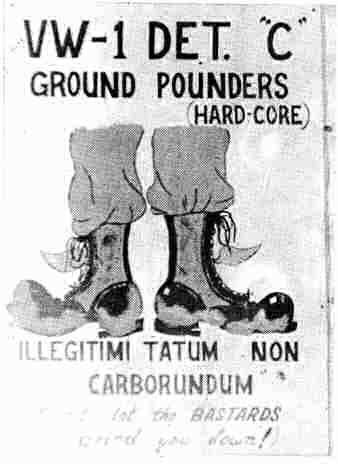 "Enjoyment, Enjoyment" the second radioman Charles "Chuck" Houston called into his mouthpiece, as the
big four engine Super Constellation headed into the teeth of Typhoon Sarah.
"Enjoyment, Enjoyment" the second radioman Charles "Chuck" Houston called into his mouthpiece, as the
big four engine Super Constellation headed into the teeth of Typhoon Sarah.
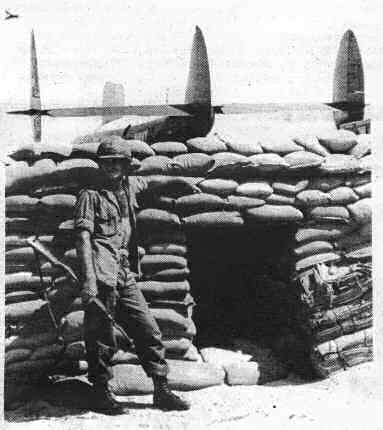 Sand Bag Shelter -- VW-1 ground crewman Lorin Schaeffer, ATR3, who looks more like a marine infantry man then
a sailor, poses outside the bomb shelter he built with the help of a few Seabees, next to the Detachment
Charlie Butler Hut. The field, sometimes shelled, is open to constant enemy attack.
Sand Bag Shelter -- VW-1 ground crewman Lorin Schaeffer, ATR3, who looks more like a marine infantry man then
a sailor, poses outside the bomb shelter he built with the help of a few Seabees, next to the Detachment
Charlie Butler Hut. The field, sometimes shelled, is open to constant enemy attack.
"Enjoyment, Enjoyment" the second radioman Charles "Chuck" Houston called into his mouthpiece, as the big four engine Super Constellation headed into the teeth of Typhoon Sarah.
"Enjoyment, hell" I said to myself, "How do I get out of here?"
It turns out that "Enjoyment" is the call word for Fleet Weather Central/Joint Typhoon Warning Center, who makes the requests for the boys at VW-1 to go out Typhoon Tracking. And typhoon tracking is literally one of the roughest jobs a guy can get in this man's navy.
How would you like to fly into the eye of a typhoon, with winds nearing 100 knots? In the dark yet? A thousand miles from the nearest land? And with first radioman Donald "Gomer" Gathorne, of Berkeley, California, drinking up all the milk aboard the ship.
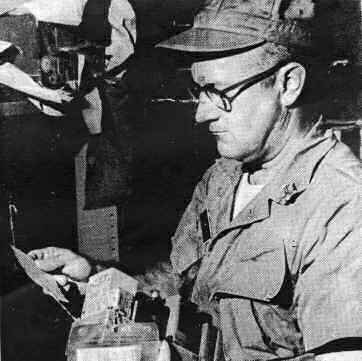 Navy Lt. Lorne Smyth, Detachment Liaison Officer who is Officer in Charge of the ground crew, looks over
replacement parts. Lt. Smyth is a career Naval Officer and maintains contact with other commands at Det. "C."
Navy Lt. Lorne Smyth, Detachment Liaison Officer who is Officer in Charge of the ground crew, looks over
replacement parts. Lt. Smyth is a career Naval Officer and maintains contact with other commands at Det. "C."
A lot of people on Guam don't know the importance of having a squadron like VW-1 on the island. It is the only weather squadron in the Pacific and one of the two in the entire world. VW-4 is based in Jacksonville, Florida, and has a similar job, tracking down Hurricanes which brew in the Atlantic or Caribbean. Recently when VW-4 left Jacksonville for a stay in Puerto Rico, and then returned to Jax, the people were so delighted to have them back they threw a big parade in downtown Jacksonville.
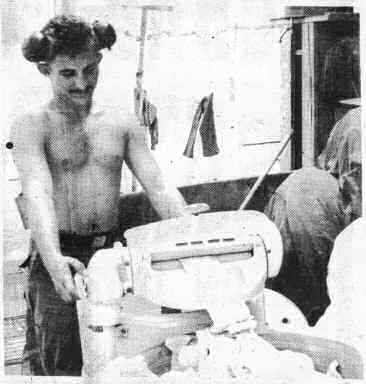 Domestic Chores -- David E. Holcomb, AN, who maintains mechanical equipment, does laundry during free hours.
David wears noise suppressors, which protect the ears from damage during roar of jet take-offs next to the
Detachment Charlie building.
Domestic Chores -- David E. Holcomb, AN, who maintains mechanical equipment, does laundry during free hours.
David wears noise suppressors, which protect the ears from damage during roar of jet take-offs next to the
Detachment Charlie building.
In Guam, VW-1 isn't completely ignored, but they just haven't received the recognition they deserve, in view of the hazards of their mission, the importance of their work, and the skills to which they bring to the island. They may have saved thousands of lives and millions of dollars worth of property damage over the years.
VW-1 has been in operation since its inception in 1952. So far this season the squadron has flown 254 "fixes" on 30 storms, three of which were typhoons with winds in excess of 100 knots, and 13 of which were typhoons with winds in excess of 65 knots. The men of VW-1 have flown over 115,000 accident-free hours since the squadron was formed, thanks to some great maintenance work, and excellent training by competent crew.
The typhoon trackers fly the Super Constellation (WC-121N), a big plane that has a length of 116 feet, a wing span of 123 feet, and a weight, loaded of 145,000 pounds. Costing about $7,000,000 originally, the four engines have 3400 horsepower in each, and the plane can carry 8750 gallons of fuel—enough to keep it in the air 20 hours if necessary.
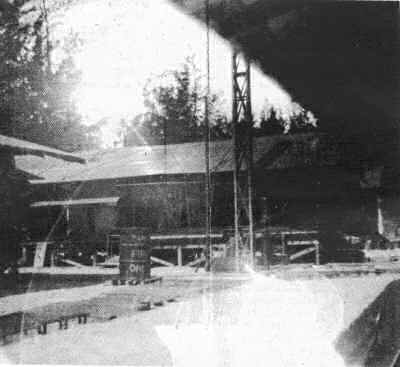 Flare LIght illuminates officer billets at "Det C." Lt. (jg) Robert Golding took this photo at midnight,
Flares light the night sky at "Det C" as marines on the field perimeter patrol for infiltrators and VC frontal
action.
Flare LIght illuminates officer billets at "Det C." Lt. (jg) Robert Golding took this photo at midnight,
Flares light the night sky at "Det C" as marines on the field perimeter patrol for infiltrators and VC frontal
action.
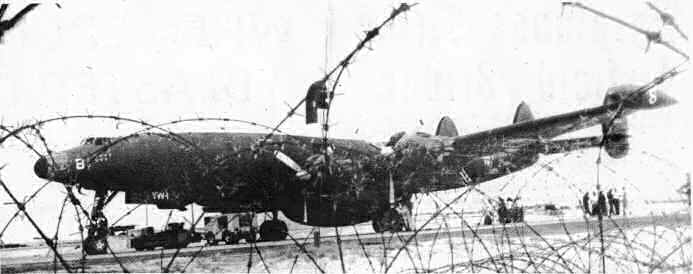 Barbed wire frames "Flower," one of the huge "Super Constellations" of VW-1. The WC-121-N is framed by a
barbed-wire barrigade which stretches along the sides of the Det. "C" landing strip. Air and ground crews get
the seven million dollar ship ready for it's flight over the Gulf of Tonkin where its radar and other equipment
will become the eyes and ears of the Seventh Fleet, watching and reporting both friendly and hostile ships and
planes.
Barbed wire frames "Flower," one of the huge "Super Constellations" of VW-1. The WC-121-N is framed by a
barbed-wire barrigade which stretches along the sides of the Det. "C" landing strip. Air and ground crews get
the seven million dollar ship ready for it's flight over the Gulf of Tonkin where its radar and other equipment
will become the eyes and ears of the Seventh Fleet, watching and reporting both friendly and hostile ships and
planes.
Commander Franklin H. Roth is the Commanding Officer of VW-1, while Cdr. R.F. Carlson is the executive officer.
The Constellations can carry a maximum of 32 men, but the usual flight crew is about 24. The normal flight is about 14 hours, and the plane carries about six tons of highly sensitive electronic gear.
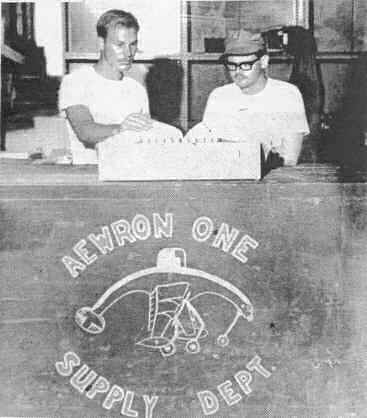 Supply Parts and Equipment -- In the Butler Hut which is Detachment Charlie's home at Det "C", Edward B. Ryan,
AKAN and Carl H. Knauer, AE3 maintain an inventory of replacement parts which keep the planes of the command in
combat readiness.
Supply Parts and Equipment -- In the Butler Hut which is Detachment Charlie's home at Det "C", Edward B. Ryan,
AKAN and Carl H. Knauer, AE3 maintain an inventory of replacement parts which keep the planes of the command in
combat readiness.
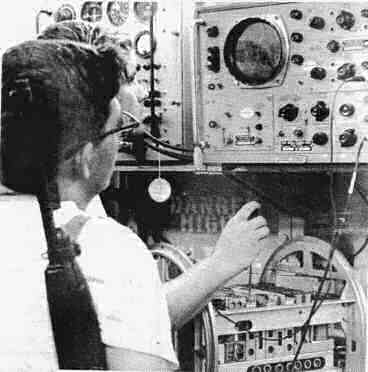 Electronics Maintenance -- Garry G. Garretson, ATN3 and Charles W. Cortez, ATR2, watch test run on a scope in
one of the refrigeration vans which have been converted for work space at Det "C". Most "ground pounders" carry
weapons, even at work.
Electronics Maintenance -- Garry G. Garretson, ATN3 and Charles W. Cortez, ATR2, watch test run on a scope in
one of the refrigeration vans which have been converted for work space at Det "C". Most "ground pounders" carry
weapons, even at work.
The squadron has about 90 officers, and 600 enlisted men. They have been based in Guam since 1957. Orders on when to fly and what "fixes" to make generally come from Joint Typhoon Warning Center, who coordinates the Air force and the Navy weather squadrons. The Air force normally makes the day-time fixes, while the Navy make the night runs.
Right now is a busy time for the typhoon trackers. November to March is considered calm, and the fliers get some well earned breaks. But during the current season they go out long and often, with as many as three typhoons under constant surveillance at all times. These typhoons must have four fixes a day, to determine their size, location, wind speed, and a variety of other information important to the specialists at Joint Typhoon Warning Center, so that chartings can be made, and warnings issued.
Without the warnings Guam could be devastated without notice, as could Taiwan, Japan, The Philippines, and Okinawa, all easy and natural targets for the deadly typhoon. The typhoon spawns near the equator, often near the Palau Islands or Kwajalein. They build up in intensity, as tropical storms, and when they reach wind speed of 64 knots and above they become full-fledged typhoons, and have to be watched carefully. In August and September there are from three to four typhoons on the average in this area.
A Typhoon is defined as a tropical cyclone located west of 180 degrees longitude, in which the maximum surface wind velocity is 64 knots or greater. In the mature stages the typical typhoon structure consists of an eye, or calm wind center, surrounded by wall clouds, heavy feeder bands, heavy turbulence, torrential rains, and destructive force winds.
Usually the same crew will fly together, although there are extras aboard, in some phase of training. The VW-1 lads fly tracking for the whole Western Pacific, and often their flights will end on Atsugi, in Japan, or Taiwan, or Okinawa or Wake Midway or Kwajalein. During the "season" many of the crew members will fly from 150-250 hours a month-which is a lot of flying time.
Let's take a typical flight into the eye of a typhoon. First, we'll meet the crew, a clean cut group of all-American boys. Right now, they're a little on the weary side, having flown 12 ½ hours last night, on Typhoon Sarah, but they're eager to go out again. Sarah was the typhoon that slammed into Wake Island late last week, ripping the island's vegetation completely off, and forcing the FAA dependents to evacuate the island. It moved due west at first and appeared for a while it would come towards Guam. Then it veered north, but still had to be followed closely because of Japan's affinity for typhoons. At last reports Sarah was hitting at Japan, and causing a good deal of damage.
The Aircraft commander is young, good looking Lt (J.G.) Joe Canghose, a native of Glendale, Calif. He graduated from Glendale Junior College, and through their aviation cadet program got interested in flying. He got his pre-flight training, and his wings at Corpus Christi, Texas in 1965. This is his first squadron, and first assignment. He has been on Guam 19 months, as pilot of the Constellation. After he leaves Guam in another few months he will be a flight instructor in Corpus Christi for a year, then he says, he will leave the Navy to fly a commercial airliner.
Next up is the co-pilot, Lt. (J.G.) Carl M Saner, a Wyoming boy, that came out with skinner Canghose, and has been flying with him ever since. The navigator is Lt (J.G.) R. C. Whitmore, with second Navigator Ens. Reginald Hammond, a new arrival on Guam. The CICO (Combat Information Center Officer) is T.D. "Ski" Bosijevac, out of Pittsburgh, Pa. who cut hair, and worked in a steel mill to get through college, and into the Commissioned Officers' ranks. His job is an important one aboard the ship, as radar control officer, he has to analyze the information received.
CICO Watch Officer aboard is LT. Clifford D. Hathaway, while the real weather expert aboard is Chief Meteorologist Ronald A. Johnson from Wisconsin. The First Flight Engineer is Darl A Beckwith, another chief. Other crew members, Second Flight Engineer; A MH2 Galen A. Filler; Crew Chief is personable, ADR2 Antonio "Tony" Corral, of El Paso; First Radioman, ATN3 Donald A. "Gomer" Gawthorne; Second Radioman, ATN3 Charles "Chuck" Houston; Electronics Crew Chief, Chief Robert E. "Buff" Burfitt; technicians ATR2 John R. Moehlenkamp "Moe", ATN2 Thomas "Tom" R. Brown; First Weatherman, AG2 Lee E. Jenner, of Nevada, Mo.; also First Weatherman Patrick "Mac" L. McQuillen, of Oshkosh B Gosh, Wisconsin; Second Weatherman Airman Christopher A. Faber; CIC Radar Operator, ATR-3 Walter H. Umphrey; AN Charles W. Jones, AN Lonnie H Hill, AN Thomas J. Tata; Training flight engineer, Kenneth A. Barfield, ADR-2; and AMH-2 T.R. Smillie.
After an hour in the wardroom, getting a briefing on the location of Sarah, and the details on what to expect in wind velocity, the seas, and other details, the men dressed in flight gear rendezvoused at the Constellation at 6:30 p.m. ready to go. Crew chief Tony Corral was running the show at that time, getting everything aboard the plane in ship-shape—particularly getting aboard a supply of food.
After a lengthy check-out, copilot Saner, and Chief Beckwith, working closely with Capt., Canghose, started up the engines and taxied out on the runway at NAS Agana. That job of taking off, loaded with tons of electronic gear, and 40,000 pounds of fuel, with thousands of gauges to check, with knobs to pull, buttons to push, toggle switches to flip, and wheels to spin has got to be the most difficult job in the world.
Then with another final check list, with final clearance from the tower, Capt. Joe raced down the runway, and pulled back on the stick, and the Constellation was aloft and flying. It was just two minutes before 7p.m.
Less than an hour later, while the men were checking out their gear, one of the airman came up to me and said: "How do you like your steak, sir?"
Well I tell you, I've seen better looking stewardesses, but that kid knew how to broil a steak. That's the difference between the Navy and the Air Force. The Air Force goes more for box lunches, while the Navy seems to feel that a man's stomach is important to the mission. Not only did the men have steak, but corn and potatoes, bread, milk, apples and everything except chocolate cake.
By 9:30p.m. we had picked up Sarah on the radar scopes. The radar, while not the most sophisticated in the world, is adequate for the typhoon work. The huge radar is housed in a bubble beneath the plane that makes the thing look slightly pregnant. Another radar, a nodding type, is housed above the plane. The interior of the ship is crowded with gear of all shapes and sizes. It looks like a flying laboratory, with electronic devises sticking out all over. It is a scene right out of Dr. No., scopes lit in eerie green, lights flashing, radios blaring, beeps coming from God knows where.
There was a certain amount of tension in the air, as we swooped down into the edge of the typhoon even though each of the men new their job wee, and had been through a hundred typhoons before. But each of them are different, and each typhoon packs a tremendous wallop, like only nature can.
There wasn't as much buffeting about as I had been led to believe by the guys in the coffee shop, who insisted I pay my life insurance premiums, and make out a will before I went up with the typhoon trackers. The plane did rock a little, but not enough to knock off a glass of water from a table.
And suddenly, at just 10p.m. we were in the eye of the typhoon. I went forward and sat in the co-pilot's seat and looked around. It was an almost indescribable scene. The moon shone down brightly, and hardly a white cap stirred on the ocean floor, clearly distinguishable below 9,000 feet down. But everywhere you looked, you could see a huge wall of ominous looking clouds that extended from the ocean to 28,000 feet. In the eye, though, there was only peace and quiet.
Technicians rushed around gathering data, a sound drop, a small parachute attached radio, was ejected from the plane to secure more data. The Meteorologist was figuring rapidly, and the radar men were transfixed to their scopes. Everybody was busy writing, and getting their all-important fix, and then trying to figure how best to break out of the eye. Ski Bosijevac made a fast decision on the heading needed, and tried to call the pilot on the intercom, but somehow the intercom went temporarily dead, and finally one of the technicians had to go forward to give him the heading out. The reports were radioed back to Joint Typhoon Warning Center even as the plane slugged it out with the awesome force of the typhoon as we tried to get out of the center calm.
By 10:30 p.m. we were out, home free, and racing towards a second typhoon, Wanda, 500 miles away, towards Marcas Island. Although the tired crew wasn't excited about going that far away, somebody had to check it out, and they were elected. Normally they would "orbit" around the typhoon for six hours until it was time to take another fix.
Heading for Wanda the crew members relaxed a little, although the radar people stuck to their scope, and navigators are always busy, plotting the coarse. We were three quarters of the way to Wanda, when Joint Warning Center radioed that another plane was on the way, so we should forget it, and head back to give Sarah one more check. Now some of the crew members sprawled out on bunks, or fell asleep at their seats, or even stretched out on the floor. Others read Playboy magazine, sat around and conversed, or drank milk—a favorite past time.
It was 3 a.m. before we got back to our favorite typhoon, Sarah for the final check of the evening. The same procedures were again followed, with the drop, flying into the eye, the fast report, relayed this time through Andersen AFB to Joint Typhoon Warning Center. The typhoon was clearly visible on the scope.
Then, as before, with just a minimum of bouncing we were out of it, and heading back to Guam. A little more coffee was consumed, a few more lies swapped, and some of the tired sailor-fliers curled up to catch some shut-eye.
Dawn was breaking over Guam as we came back in. The island looked pretty peaceful as we came back, directly over Andersen, to the runway. It was a good flight. We had done the job with a minimum of trouble, and the people of the Western Pacific were just a little safe because of it.
Flying the typhoons isn't the only mission for Airborne Early Warning Squadron one by no means. Many of their nine planes are out continually in combat support for the Seventh Fleet, stationed off the Vietnam Coast. In 1966, for instance, the squadron flew more than 10,000 hours. A total of 5226.7 hours were flown in combat support, on 344 separate flights. For this work the men of VW-1 has received 165 medals, and 525 personnel have earned the Vietnam service medal. Although much of VW-1's assignments are classified, it is no secret that the weather planes do yeoman duty in observing weather over N. Vietnam before the carrier planes and the Air Force planes make their strikes.
Because the important weather reconnaissance, and the combat support, the squadron also flew 1,190 training hours last year, to upgrade pilots and crewmembers. The also worked with NASA on missions, and helped fly R & R flights.
All in all, it's a pretty talented crew, in a very important squadron, with a tremendously urgent mission.
Because of them the people of Guam, Okinawa, Taiwan, Japan and a lot of islands in between can go to bed at night, and not worry about a typhoon whistling down on them without fair and adequate warning. If there is a typhoon anywhere in the Pacific the Typhoon Trackers knew about it.
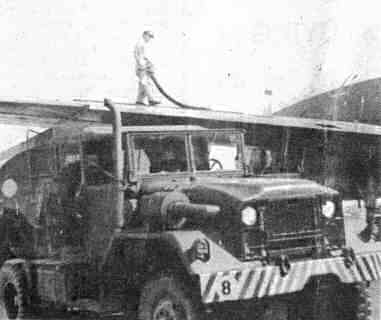 Flight Engineer Clayton H. Shugars, ADR1 refuel plane after returning from combat reconnaissance patrol. Other
crewmen are working on other jobs to ready the ship for another mission in the air.
Flight Engineer Clayton H. Shugars, ADR1 refuel plane after returning from combat reconnaissance patrol. Other
crewmen are working on other jobs to ready the ship for another mission in the air.
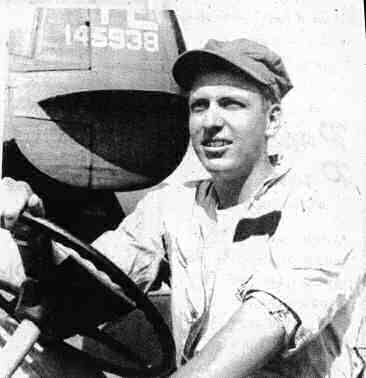 Combat Information Center leading Petty Officer Robert S. Wagner, AX3, drives a tow tractor during ground
support work as the the flight crew readies the ship for another mission.
Combat Information Center leading Petty Officer Robert S. Wagner, AX3, drives a tow tractor during ground
support work as the the flight crew readies the ship for another mission.
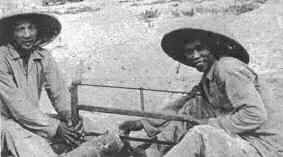 Two workers saw a bamboo post.
Two workers saw a bamboo post.
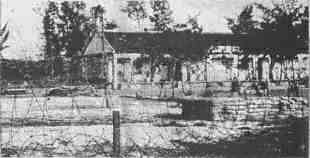 Barbed wire protects a Vietnamese building inside the base area.
Barbed wire protects a Vietnamese building inside the base area.
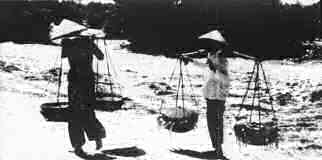 Peasants tote merchandise to a market
Peasants tote merchandise to a market
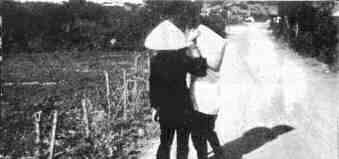 Village women gossip and view heavily wooded area where they, too, fear to go -- unable to identify even their
own kind as friend or VC sympathizer. One VC infiltrator recently killed inside the area installation was later
identified as a local hire barber who workd on the base.
Village women gossip and view heavily wooded area where they, too, fear to go -- unable to identify even their
own kind as friend or VC sympathizer. One VC infiltrator recently killed inside the area installation was later
identified as a local hire barber who workd on the base.

